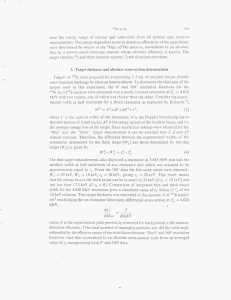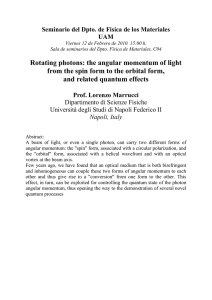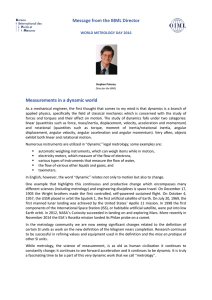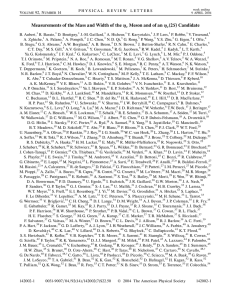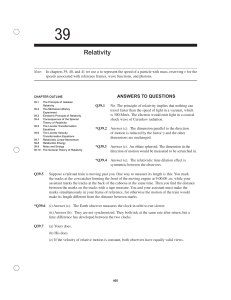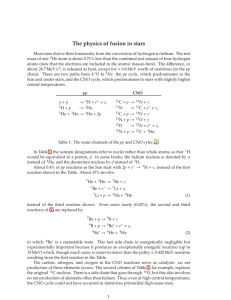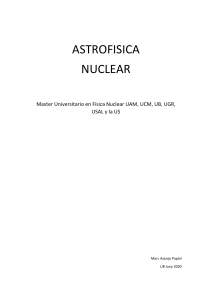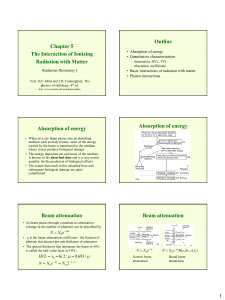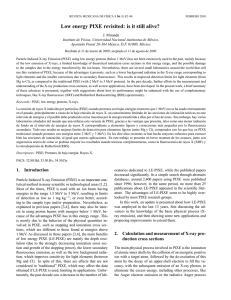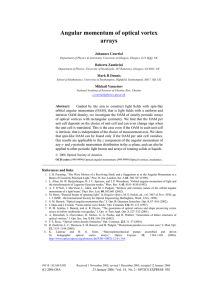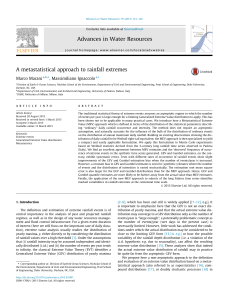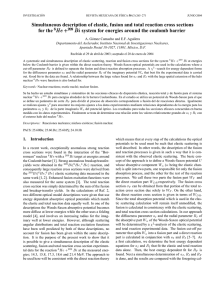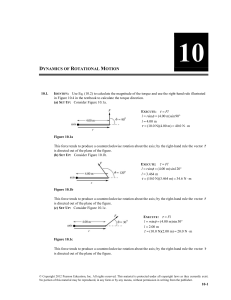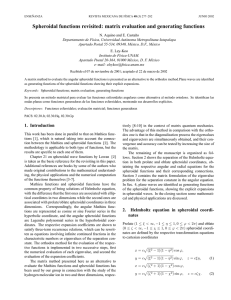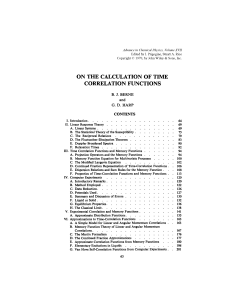Care was taken in establishing this potential to see that the
Anuncio
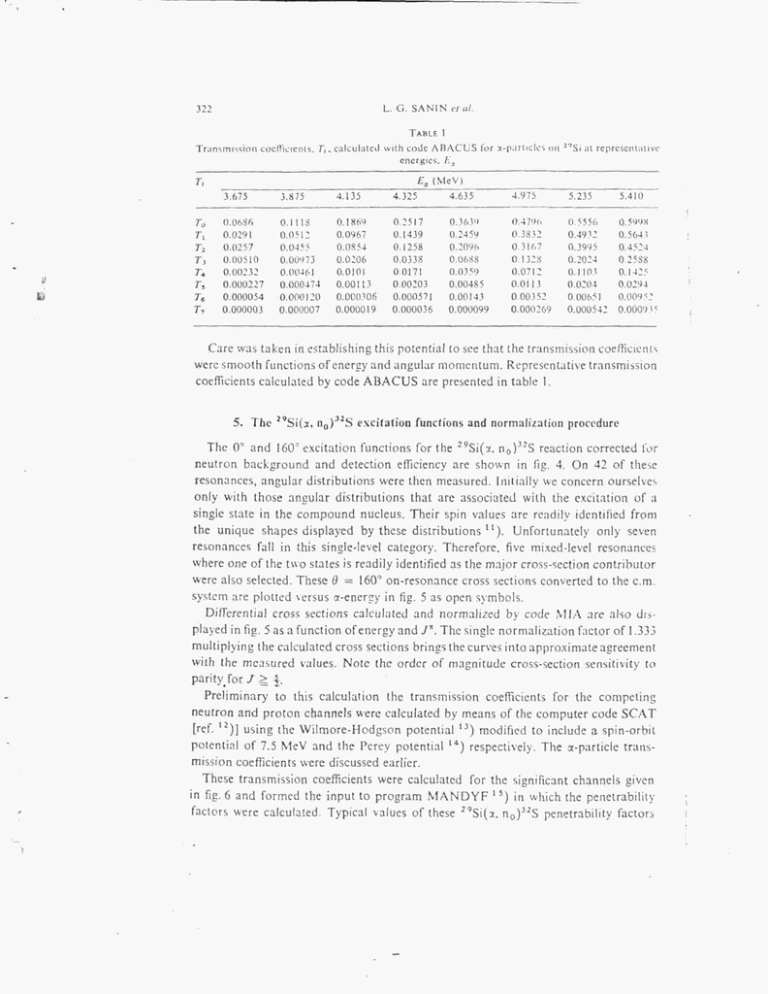
322 L. G. SANIN era/. TABLE 1 Transmission cocrticients. T,, calculated with code ABACUS for a-particIcs on ^''Si at representative energies, E^ £, (MeV) T, To r, Tz Ti r. 7-, 7-6 T-, 3.675 3.875 4.135 4.325 4.635 4.975 5.235 5.410 0.06S6 0.0291 0.0257 0.00510 0.00232 0.000227 0.000054 0.000003 0.1 lis 0.0512 0.0455 0.00973 0.00461 O.O00474 0.000120 0.000007 0.1869 0.0967 0.0854 0.0206 0.0101 0.00113 0.000306 0.000019 0.2517 0.1439 0.1258 0.0338 0.0171 0.00203 0.000571 0.000036 0.3639 0.2459 0.2096 0.0688 0.0359 0.00485 0.00143 0.000099 0.4796 0.3832 0.3167 0.1328 0.0712 0.0113 0.00352 0.000269 0.5556 0.4932 0.3995 0.2024 0.1103 0.0204 0.00651 0.000542 0.599,S 0.5643 0.4524 0.2588 0.1425 0.0294 0.00952 0.000935 Care was taken in establishing this potential to see that the transmission coefficienls were smooth functions of energy and angular momcntum. Representative transmission coefficients calculated by code ABACUS are presented in table 1. 5. The "Si(a, no)''^S e.vcitation functions and normalization procedure The 0° and 160° excitation functions for the ^'SÍ(D(, no)''^S reaction corrected for neutrón background and detection efficiency are shown in fig. 4. On 42 of these resonances, angular distributions were then measured. Initially we concern ourselves only with those angular distributions that are associated with the excitation of a single state in the compound nucieus. Their spin values are readily identified from the unique shapes displayed by these distributions ^'). Unfortunately only seven resonances fall in this single-level category. Therefore, five mixed-level resonances where one of the two states is readily identified as the major cross-section contributor were also selected. These 9 = 160° on-resonance cross sections converted to the c.m. system are plotted versus a-energy ínfig.5 as open symbols. DiíTerential cross sections calculated and normalized by code MÍA are also displayed infig.5 as a function of energy and J". The single normalization factor of 1.333 multiplying the calculated cross sections brings the curves into approximate agreement with the measured values. Note the order of magnitude cross-section sensitivity to parity f o r / ^ \ . Preliminary to this calculation the transmission coeflücients for the competing neutrón and protón channels were calculated by means of the computer code SCAT [ref ' ' ) ] using the Wilmore-Hodgson potential '•') modified to include a spin-orbit potential of 7.5 MeV and the Perey potential '*) respectively. The a-particle transmission coefficients were discussed earlier. These transmission coefficients were calculated for the significant channels given in fig. 6 and formed the input to program MANDYF " ) in which the penetrability factors were calculated. Typical values of these ^'51(3, no)''^S penetrability factors " S i ( a , n) (JS/quu) N0IÍ03S SSOdO 323 AdOlVaOSVl L. G. SANIN et <il. 324 ° • «3/2 • 5/2 -5'2* , • ' • 7/2 .0 0.1 y ^ ^ : - - - - ^'^^ ' 1 y y 4.0 ^ . ALPHA 5.5 1 45 5.0 . 1 ENERGY (MeV) . I Fig. 5. Normalized theoretical ^''Siía. n o ) ' ' S excitation functions and measured on-rcsonaiicc cross sections at 160' for spin J, \ , \ and \ states in ^^S. Solid symbols indícate a puré, singlc-lcvel resonance is measured whereas open symbols indicate that a secondary state is also conlributing. TABLE 2 Penetrability factors calculated with code M A N D Y F for the ^'Siía. no)^^S reaction at representative energies. C^, for specitic •'•'S states, J " J" E^ (MeV) 3.675 j- 0.0281 0.0612 í0.0278 1 + 0.0212 0.0042 s *• 0.0231 1 ' 0.00416 7 + 0.000313 0.000006 2 ~ 2* 0.000752 • 0.000010 O.OOOOOO 1 •• \- V- V* 3.875 0.0479 0.0929 0.0470 0.0335 0.00711 0.03S4 0.00716 0.000282 0.000009 0.000938 0.000016 0.000000 4.135 4.325 4.635 4.920 5.235 5.410 0.0843 0.1405 0.0810 0.0552 0.0116 0.0673 0.0124 0.000786 0.000017 0.000278 0.000031 0.000000 0,1158 0.1739 0.1086 0.0714 0.0153 0.0924 0.0170 0.00106 0.000041 0.00324 0.000060 O.OOOOOO 0.1397 0.2165 0.0990 0.0589 0.1580 0.2373 0.1035 0.0701 0.0114 0.1170 0.0156 0.00165 0.000045 0.000720 0.000108 0.000002 0.1693 0.2410 0.1087 0.0796 0.0171 0.1378 0.0227 0.00204 0.000072 0.00949 0.000195 0.000002 0.1715 0.2374 0.1102 0.08.^0 0.0214 0.1471 0.027'» 0.00235 0.000088 0.0115 0.000247 0.000003 0.00822 0.0922 0.0115 0.00139 0.000038 0.00505 O.OOOO.Sl 0.000000 are Usted in table 2. On the basis of their dependencies, the cross-section curves refiect a sensitivity to energy and / " valué of the ""^S compound nucieus state. 6. Analysis of on-resonance angular distributions Early in these studies, we established the importance of measuring as full, detailed, init nrcri<;p an angular distribution as possible on each resonance if a meaningful
